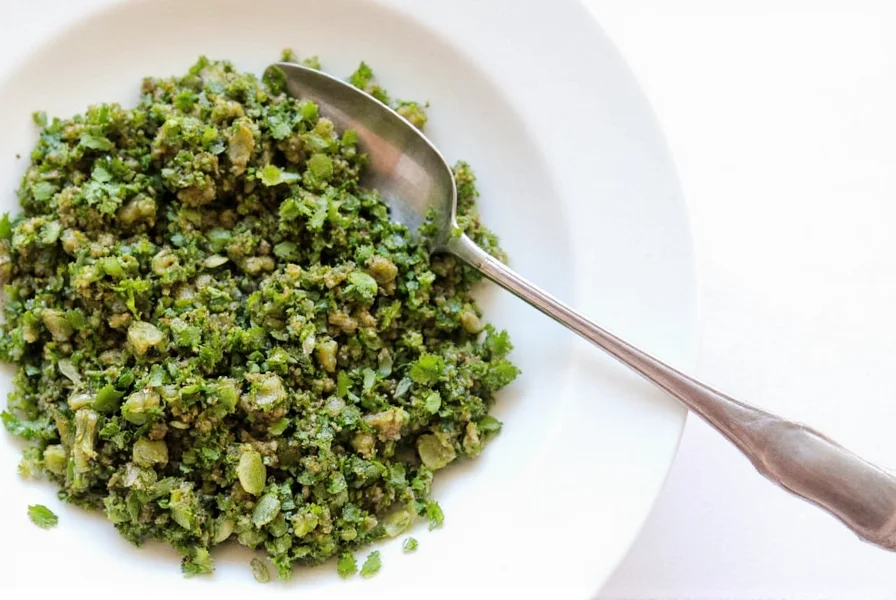Table of Contents
Introduction to Dried Cilantro
Dried cilantro is a versatile ingredient that delivers concentrated flavor when fresh isn't available. Unlike fresh cilantro's bright citrus notes, dried cilantro offers a deeper, earthier profile ideal for cooked dishes. This guide covers exact substitution ratios, recipe-specific applications, and expert storage techniques to maximize flavor in every meal.

Fresh vs. Dried Cilantro: Key Differences
Fresh cilantro provides vibrant, citrusy flavor and delicate texture perfect for garnishes and raw dishes. Dried cilantro has a more robust, earthy taste that intensifies during cooking but lacks fresh notes. Key differences:
- Flavor profile: Dried cilantro loses its bright citrus notes and develops smoky, herbal undertones
- Usage timing: Add dried cilantro early in cooking (15-20 minutes before finishing) to release oils; fresh should be added at the end
- Substitution ratio: Use 1 teaspoon dried = 3 teaspoons fresh for most recipes
Creative Uses for Dried Cilantro in Recipes
Maximize dried cilantro's unique flavor with these recipe-specific applications:
- Taco seasoning: Mix 1 tsp dried cilantro + 1 tsp cumin + 1/2 tsp chili powder + 1/4 tsp garlic powder for smoky, authentic flavor
- Stews and soups: Add 1/2 tsp per serving at the start of cooking; ideal for chili, lentil soup, or bean dishes
- Roasted vegetables: Toss potatoes or carrots with olive oil, salt, and 1 tsp dried cilantro before roasting for earthy depth
- Marinades: Combine with lime juice, olive oil, and cumin for chicken or fish (add 5 minutes before cooking)
- Bread and crackers: Add 1/2 tsp per cup of flour to homemade flatbreads for subtle herbal notes
Practical Tips for Using Dried Cilantro
Follow these expert techniques to avoid bitterness and maximize flavor:
- Start small: Begin with 1/4 tsp per serving and adjust—overuse creates bitter notes
- Rehydrate for cold dishes: Soak in 1 tbsp warm water or broth for 5 minutes before adding to salads or dips
- Storage optimization: Keep in a dark glass jar with a tight lid in a cool, dry cupboard; avoid plastic containers that absorb odors
- Flavor pairing: Best with tomatoes, onions, garlic, cumin, and lime; avoid pairing with delicate herbs like basil
- Testing freshness: Rub between fingers—if no strong aroma, replace it
Frequently Asked Questions
Can I use dried cilantro in salsa or guacamole?
Not recommended. Dried cilantro lacks the bright, fresh flavor essential for raw dishes. For salsa or guacamole, always use fresh cilantro. Use dried only in cooked salsa variations like enchilada sauce.
What's the exact substitution ratio for dried vs. fresh cilantro?
Use 1 teaspoon dried cilantro = 3 teaspoons fresh for most cooked dishes. For delicate recipes like rice or quinoa, start with 1/2 tsp dried per cup of grain and adjust. Never use equal amounts—dried is 3x more concentrated.
How long does dried cilantro last before losing flavor?
Properly stored in an airtight glass jar away from light and heat, dried cilantro maintains peak flavor for 12-18 months. After 2 years, it will still be safe but lose potency. Test by rubbing a pinch between fingers—if no strong aroma, replace it.
Can I rehydrate dried cilantro for salads?
Yes. Soak in warm water, broth, or lime juice for 5-10 minutes to restore texture. Drain excess liquid before adding to salads. Note: Rehydrated dried cilantro won't match fresh texture but works well in warm salads or grain bowls.
Why does dried cilantro sometimes taste bitter?
Bitterness occurs from overuse or adding too late in cooking. Always start with small amounts (1/4 tsp per serving) and add during the first 10-15 minutes of cooking. Avoid using in raw applications where fresh cilantro is ideal.
Is dried cilantro good for spice blends?
Excellent! It's a key ingredient in homemade taco seasoning (1 tsp per batch), curry powder (1/2 tsp), and chili rubs. Its earthy notes complement cumin, paprika, and garlic powder perfectly.
Buying Guide for Dried Cilantro
Select high-quality dried cilantro with these criteria:
| Feature | Description |
|---|---|
| Source | Choose organic or farm-direct suppliers with transparent sourcing (e.g., "grown in California" or "certified organic") |
| Appearance | Vibrant green color with no brown spots or mold; avoid dull or yellowish batches |
| Smell | Strong, herbal aroma with no musty or stale notes; test by opening the container |
| Texture | Crumbly and dry—no clumping or dampness which indicates moisture exposure |
| Packaging | Opaque glass jars or resealable foil bags that block light; avoid clear plastic containers |
Advantages and Use Cases
Dried cilantro excels in long-cooking dishes like stews, soups, and spice rubs where heat releases its full flavor. It's ideal for meal preppers, busy cooks, and regions where fresh cilantro is scarce. Unlike fresh, it has 12-18 months shelf life without refrigeration.
Target Audience
Perfect for home cooks seeking convenience, professional chefs needing consistent flavor, and those with dietary restrictions (e.g., low-FODMAP diets where fresh herbs cause issues). Also valuable for international cooks using cilantro in traditional recipes year-round.
Suitable Occasions
Best for: weeknight dinners, batch cooking, spice blending, and dishes requiring long simmering times. Avoid for fresh salsas, ceviche, or garnishes where bright herb flavor is essential.
Conclusion
Dried cilantro is a powerful kitchen tool when used correctly. By understanding its distinct flavor profile, using precise substitution ratios, and storing properly, you can elevate cooked dishes without compromising quality. Remember: it's not a fresh substitute but a complementary ingredient for specific applications. Always test small amounts first and prioritize quality sourcing for best results.










 浙公网安备
33010002000092号
浙公网安备
33010002000092号 浙B2-20120091-4
浙B2-20120091-4